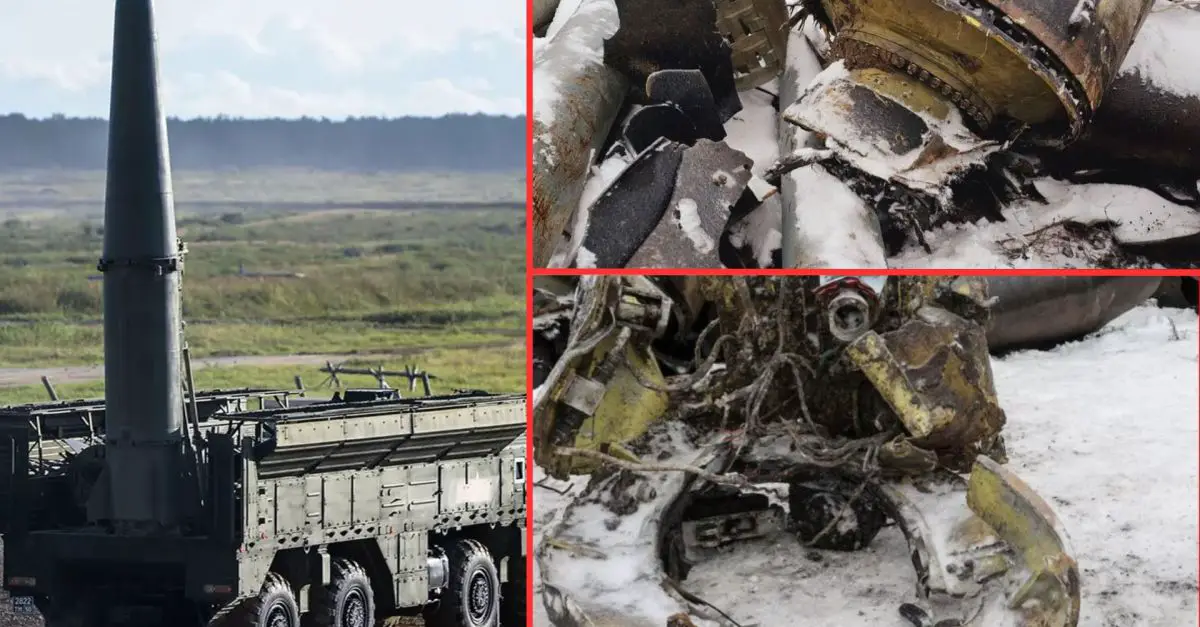Breaking news
Russia testing north Korean ballistic missile in warzone.
The debris from a missile that landed in the Ukrainian city of Kharkiv on January 2 came from a North Korean ballistic missile of the Hwasong-11 series, UN sanctions observers told a Security Council committee in a report seen by Reuters on Monday.
Follow Army Recognition on Google News at this link

Hwason-11 on mobile tractor erector launcher system, right Hwasong-11 near Kharkiv (Picture source: North Korean communication ministry-Left-, OSINT -Right-)
In the 32-page report, UN sanctions observers concluded that "the debris recovered from a missile that landed in Kharkiv, Ukraine, on January 2, 2024, originated from a Hwasong-11 series missile from the DPRK" and constitutes a violation of the arms embargo imposed on North Korea.
Formerly known as the Democratic People’s Republic of Korea (DPRK), North Korea has been subject to UN sanctions for its ballistic missile and nuclear programs since 2006, and these measures have been strengthened over the years.
Three sanctions observers traveled to Ukraine earlier in the month to inspect the debris and found no evidence that the missile had been manufactured by Russia. They "were not able to independently identify where the missile was launched from, nor by whom."
"The trajectory information provided by the Ukrainian authorities indicates that it was launched from the territory of the Russian Federation," they wrote in a report to the Security Council's North Korea sanctions committee on April 25.
"Such a location, if the missile was under the control of Russian forces, would likely indicate that it had been purchased by nationals of the Russian Federation," they said, adding that this would constitute a violation of the arms embargo imposed on North Korea in 2006.
The Russian and North Korean missions to the United Nations in New York did not immediately respond to a request for comments on the sanctions observers’ report.
The United States and others have accused North Korea of transferring weapons to Russia for use against Ukraine, which it invaded in February 2022. Moscow and Pyongyang have denied these accusations, but last year pledged to deepen their military relations.
At a UN Security Council meeting in February, the United States accused Russia of launching ballistic missiles provided by the DPRK against Ukraine on at least nine occasions.
UN observers stated that the Hwasong-11 series ballistic missiles were first publicly tested by Pyongyang in 2019.
The Hwasong-11 is likely similar in design and function to other missiles in the Hwasong series, which includes both short-range and intercontinental ballistic missiles (ICBMs), Hwasong-11 is estetically close to the russian 9K720 Iskander
. These missiles are typically designed to be launched from mobile platforms, which provide strategic flexibility and survivability. The development of such missiles is part of North Korea's broader efforts to bolster its defense and project power regionally and, potentially, intercontinentally
Last month, Russia vetoed the annual renewal of the UN sanctions observers, who have been monitoring the enforcement of UN sanctions against North Korea on its nuclear and ballistic missile programs for 15 years. The current Panel of Experts’ mandate expires on Tuesday.
On the days of January. During the December 2 attack, the prosecutor's office of the Kharkiv region presented to the media fragments of the missile, stating that it was different from Russian models and that "it could be a missile provided by North Korea."
In response to the escalating situation, Operation "Crabe" was launched between January 30 and February 8, 2024, deploying tracked vehicles HT 270 for the first time to combat illegal gold mining. Previously, the 3rd Foreign Infantry Regiment (3 REI) relied on Bandvagn 206 (BV 206) vehicles. The decision to integrate HT 270 vehicles, acquired through the Union of Public Procurement Groups and militarized by Technamm, reflects a strategic shift in tackling the challenge posed by illegal mining activities.
The HT 270, equipped with a 169hp diesel engine and capable of carrying up to 16 infantrymen, marks a significant upgrade in mobility and firepower. Its deployment during Operation "Crabe" underscores the military's commitment to adapt and utilize advanced technology to combat illicit activities effectively. With a maximum speed of 58 km/h and a mount for a 7.62mm MAG 58 machine gun, the HT 270 enhances the operational capabilities of the Armed Forces in confronting the complex and evolving threat posed by illegal gold mining.
Despite these efforts, the persistence of illegal mining activities fueled by high gold prices and transnational networks underscores the need for sustained and coordinated action to address the root causes of the issue and safeguard the environment and local economies in French Guyana.


























